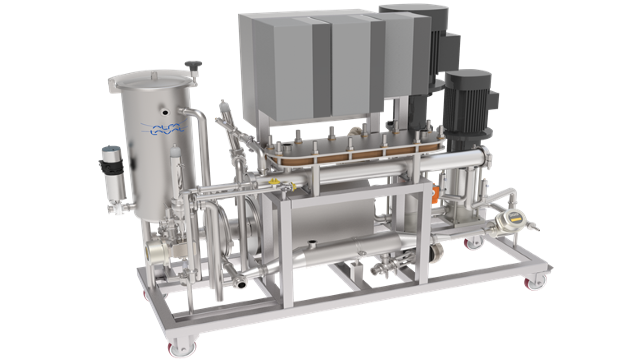Installations pilotes autonomes
Alfa Laval offers a wide range of small-scale units and pilot plants which are ideal for on-site testing. Valuable data is gained for evaluation of process feasibility, determination of design and up-scaling, optimization of existing production lines or processing of high-value products
Small-scale units and pilot plants
In order to ensure the optimum solution, it is often advisable to conduct experiments on a small scale. These can be used to establish process feasibility, determine design data for up-scaling, optimize existing production lines or even carry out small-scale processing of high-value and/or low-volume products.
Our range of small-scale units and pilot plants is based on the unique plate-and-frame modules or the full-fit sanitary spiral elements, or a combination of both. The sizes vary from only a few litres of test media volume in the Alfa Laval LabUnits up to 1,000 litres in the Alfa Laval PilotUnits. it is possible to test all filtration processes: Reverse osmosis, nanofitration, ultrafiltration and microfiltration.
On-site testing or at Alfa Laval pilot facilities
Alfa Laval provides small-scale modules, units and pilot plants for testing on-site in connection with other process equipment and for testing at our own state-of-the-art Membrane and Application Development Test Centre in Nakskov, Denmark. In both cases, we also provide highly skilled process consultancy services.
Benefits
- You can make the first screening evaluations in your own laboratory and thus get the correct answers to vital questions
- The same design is used for both small-scale and industrial scale equipment which allows you to develop new processes and products
- The data gathered is accurate and reliable for easy up-scaling
- Alfa Laval has its own membrane and application development test centre where experts are ready to help you with process know-how and test work
- You can conduct experiments with both plate-and-frame and spiral wound module configurations - and all filtration processes
Comment fonctionne la filtration membranaire ?
Séparation physique
La filtration membranaire est un processus de séparation physique dans lequel la force motrice consiste en une différence de pression entre les deux côtés d'une membrane spéciale. Ce processus se définit par sa capacité à séparer des molécules de tailles et de caractéristiques différentes. La quasi-totalité de la filtration membranaire industrielle est réalisée sous la forme d'une filtration tangentielle, où le liquide à filtrer s'écoule parallèlement à la membrane à une vitesse élevée et sous pression.
Barrière physique
La filtration membranaire consiste à faire passer un flux d'alimentation unique à travers une membrane qui le sépare en deux flux distincts, le perméat et le rétentat. La membrane est une barrière physique aux caractéristiques très spécifiques - une barrière que seuls certains composants choisis peuvent traverser.
Passage à travers
Les pores de ce type de membrane sont si petits qu'ils se mesurent en angströms (10-10 m) et une pression est nécessaire pour forcer le liquide à les traverser. Les pores des membranes utilisées pour la nanofiltration et l'osmose inverse sont si petits qu'ils ne sont pas visibles, même au microscope.
Long experience with membranes
Alfa Laval's experience within membrane filtration dates back almost as far as the technology itself, and we wish to share our experience with you.

